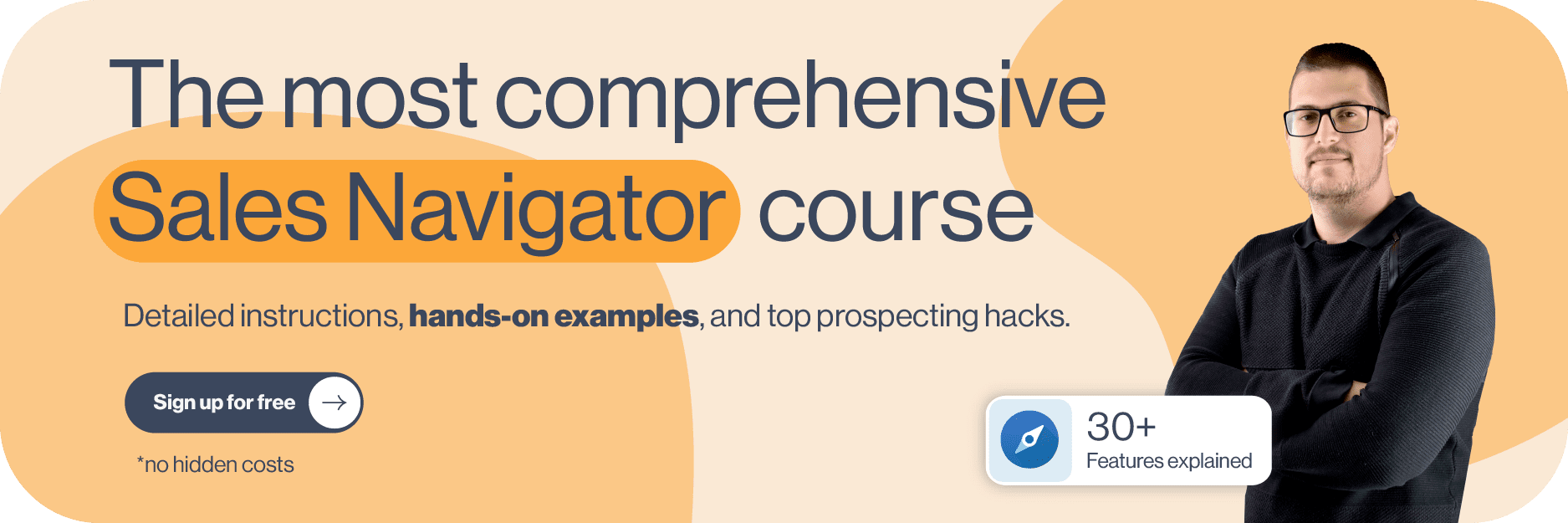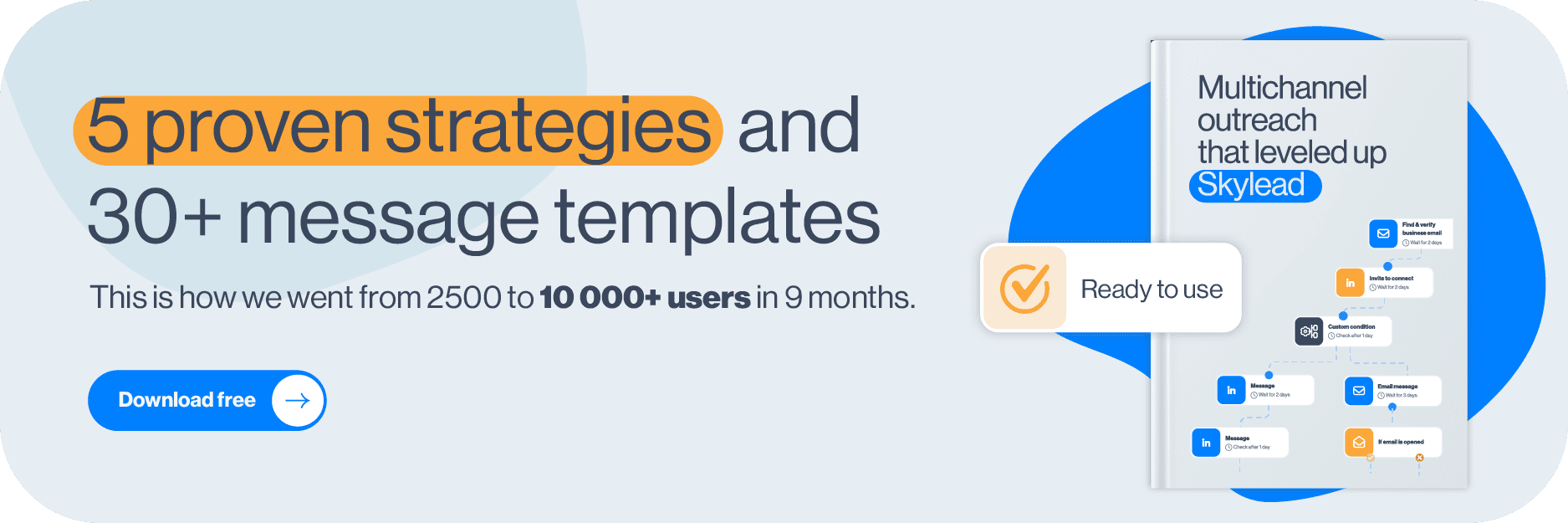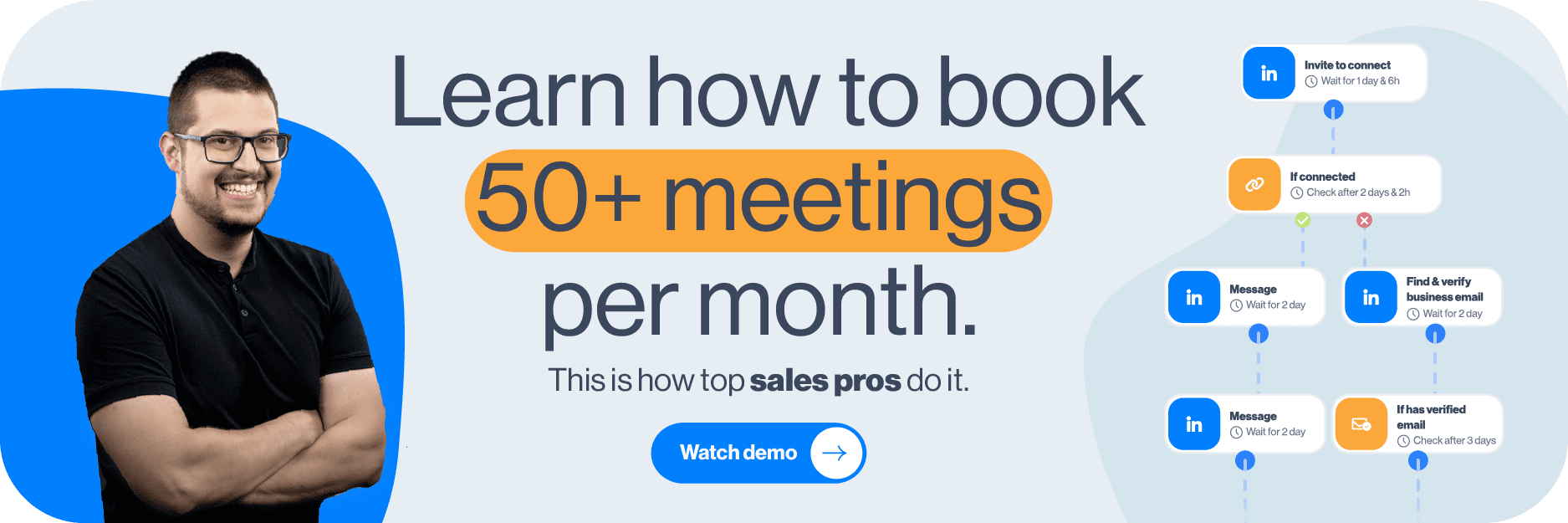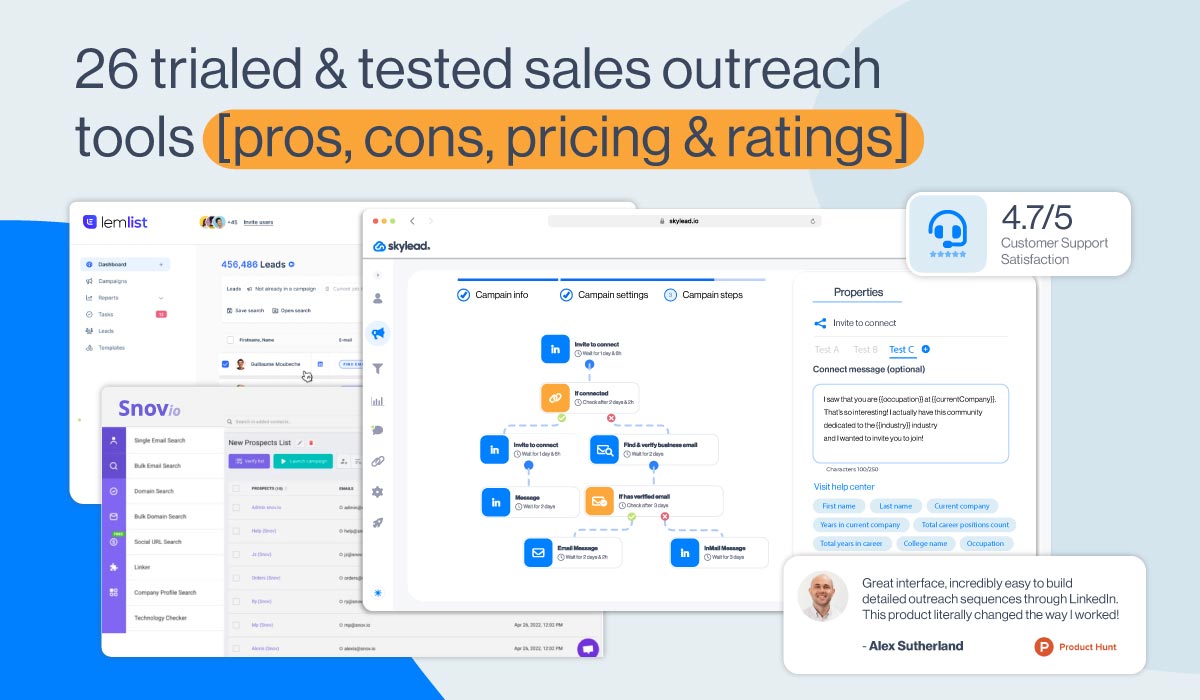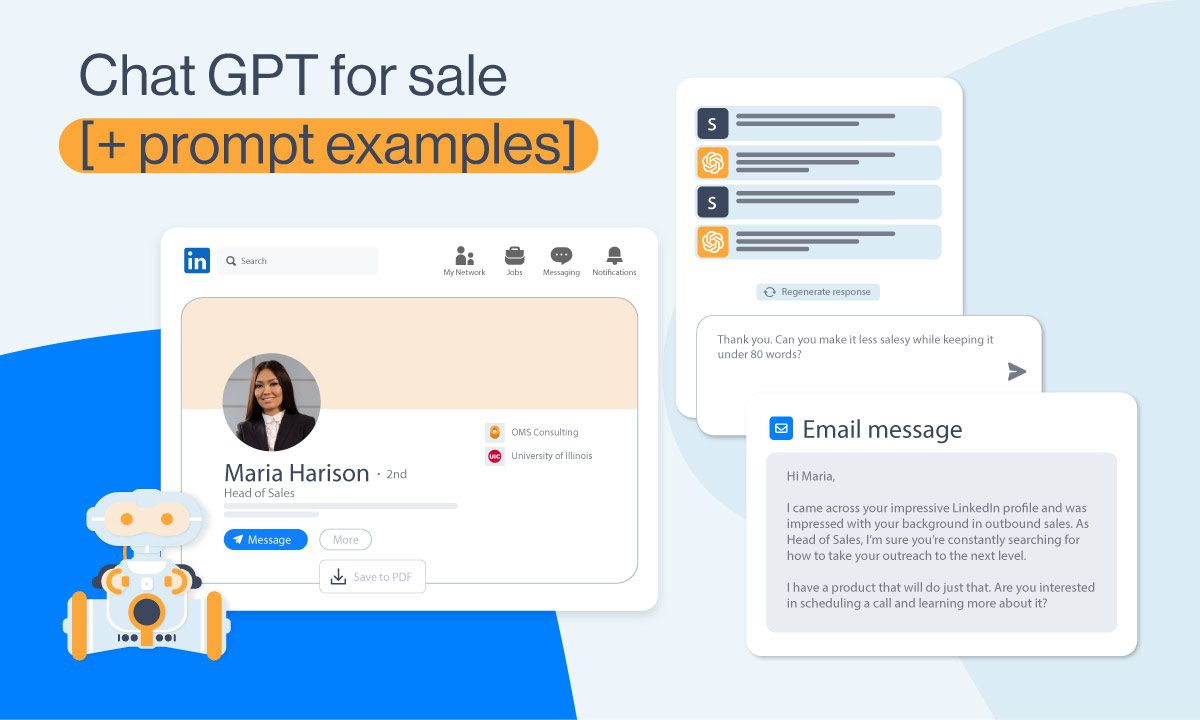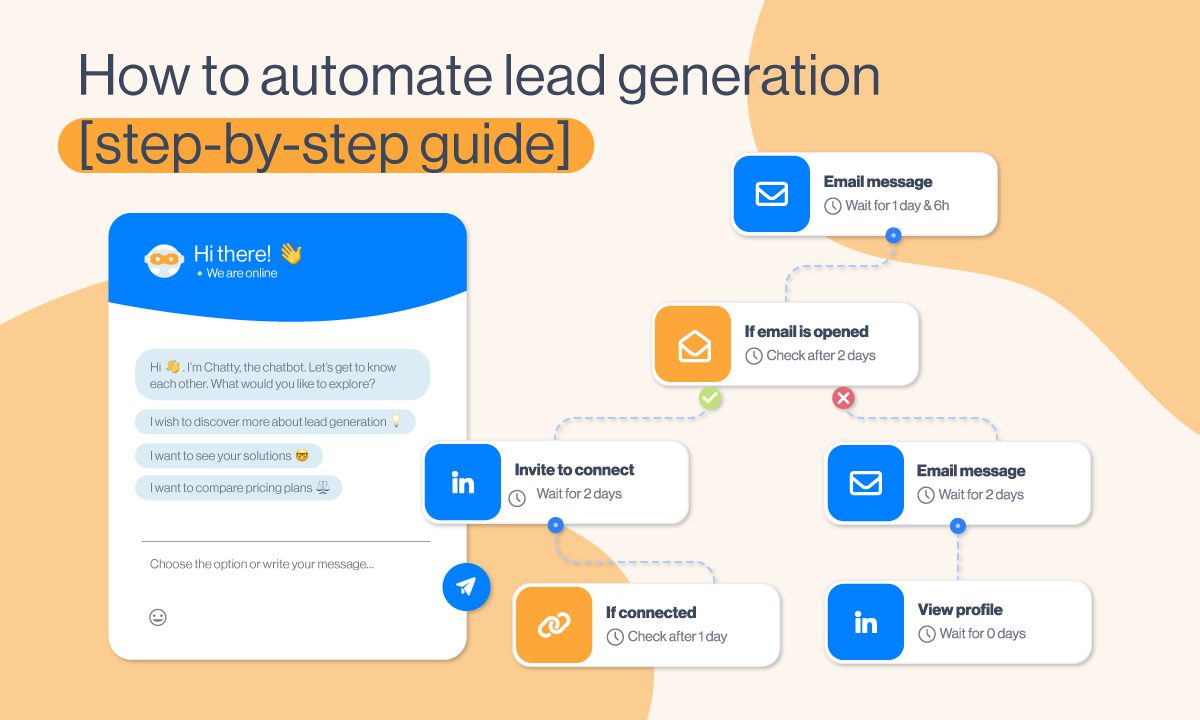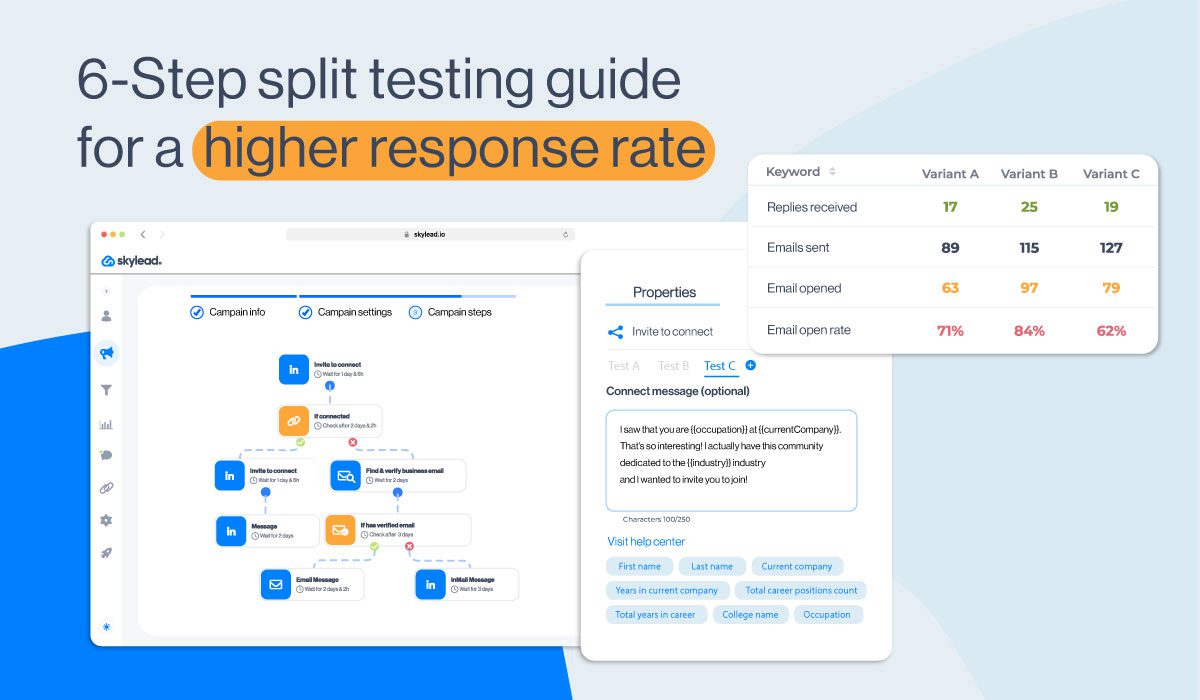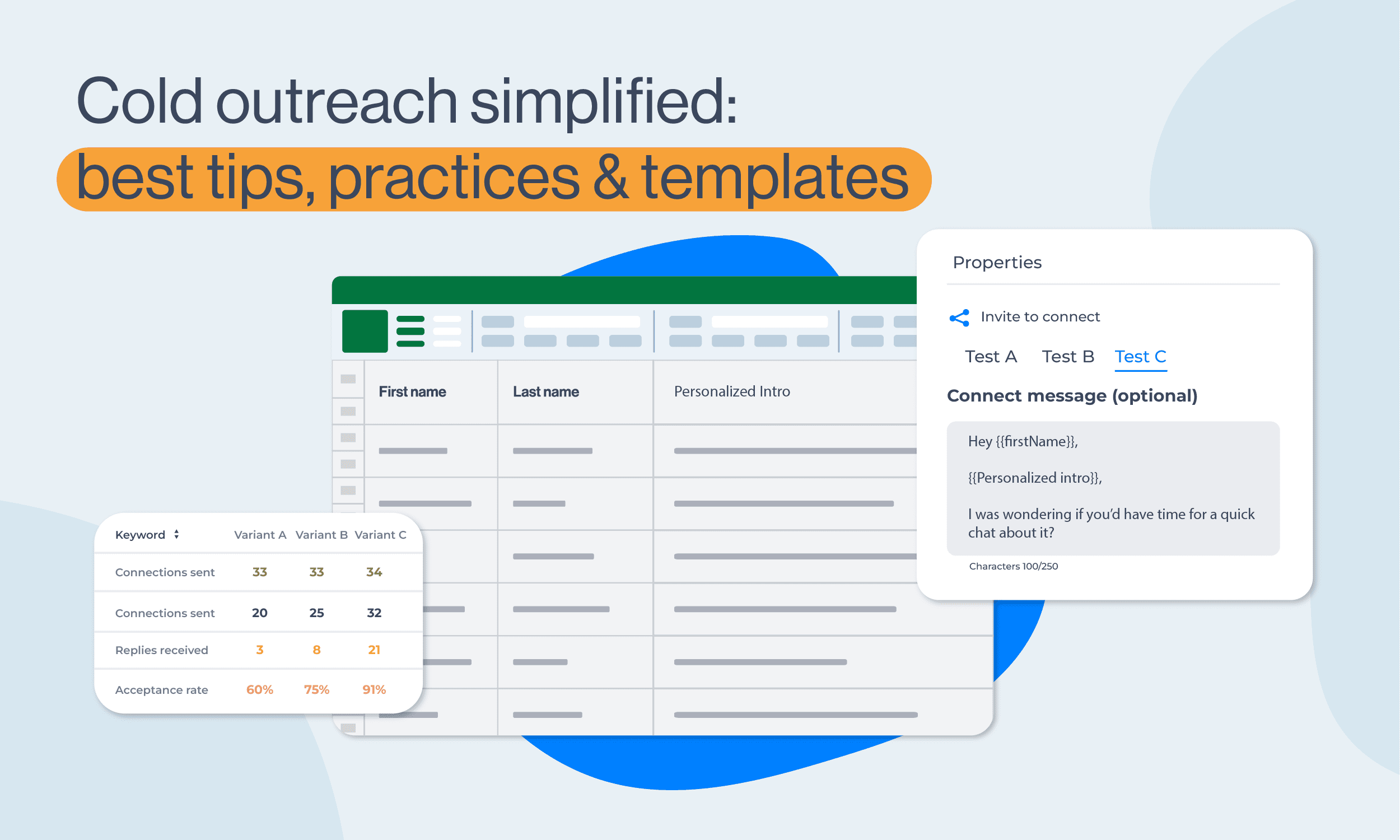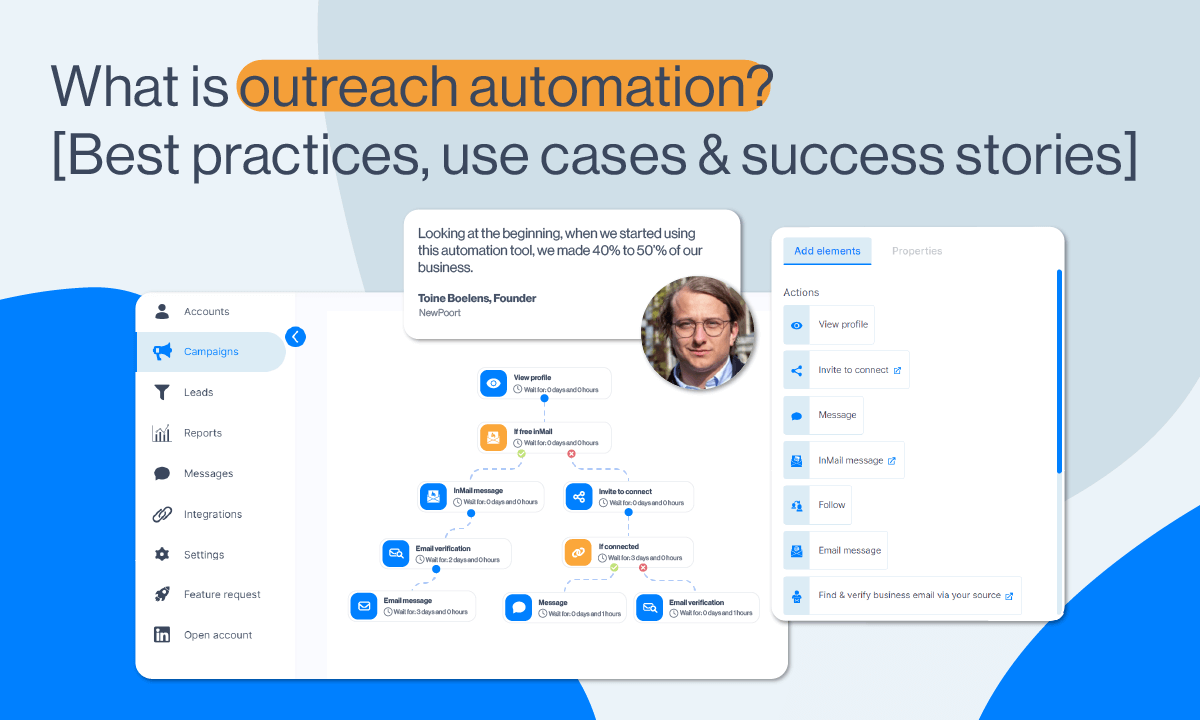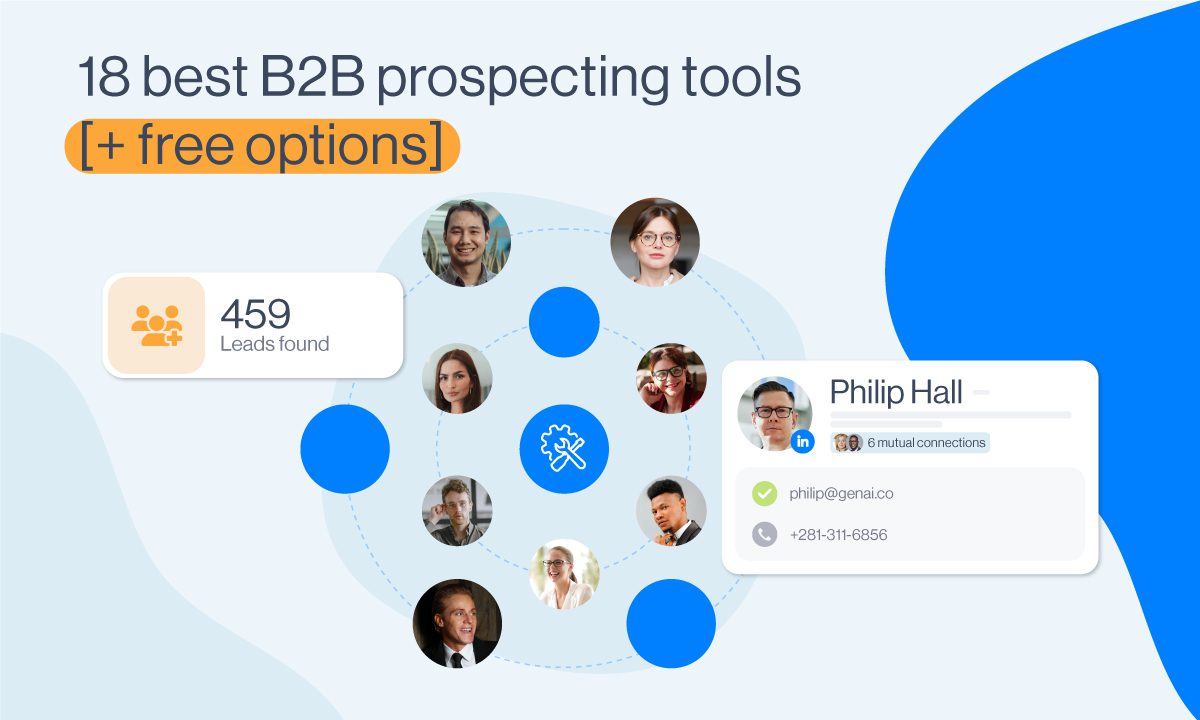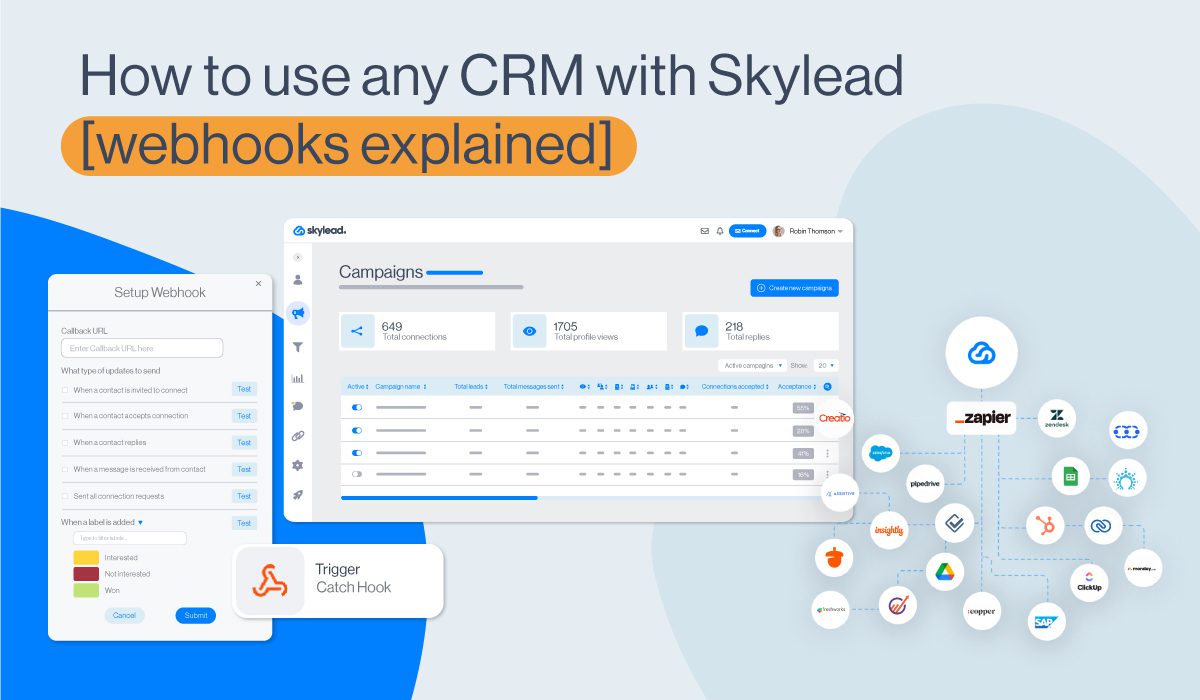Objection handling playbook: 7 steps to master [+ 17 winning scenarios]
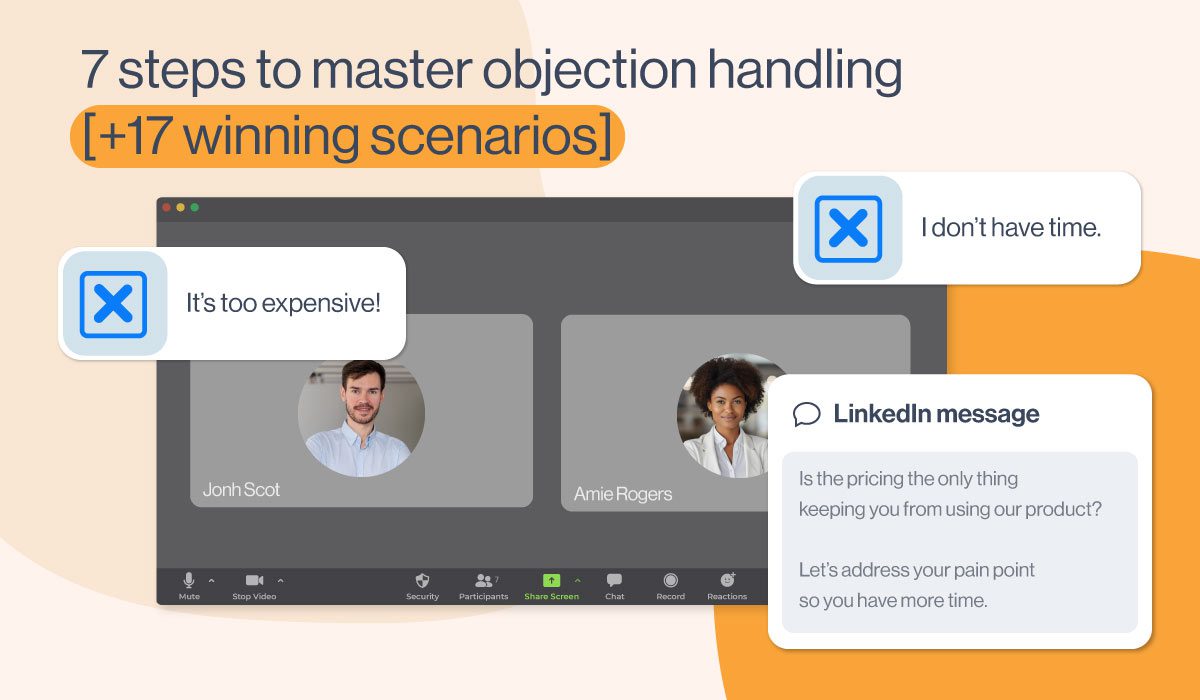
When talking to prospects, sales reps know that the art of selling revolves around many skills. However, the most important one, hands down, is objection handling.
Prospects might give you many reasons why they don’t need your product/service, from “it’s too expensive,” “I don’t have time,” to “I’m happy with your competitor.” Ouch! We know–it might hurt, but your job is to overcome these obstacles.
But how to turn a “no” into a “yes”? To teach you how to do it, we are drawing from years of our own sales experience to show you:
- Types of objection handling
- A 7-step guide to master handling in sales
- Top 17 objection-handling situations with winning rebuttal examples
What is objection handling in sales?
Objection handling is the process of addressing concerns or doubts raised by a prospect. It uses empathetic listening and other communication techniques to provide solutions or reassurance, with the goal of maintaining a positive relationship and moving closer to a more successful outcome or sale.
Objections may come up for various reasons:
- Poor LinkedIn prospecting
- Failing to find your Ideal customer profile or Buyer Persona from LinkedIn lead generation.
Of course, it could be none of the above. You could have done everything right, yet objections may pop up to create very common outreach obstacles like:
- Inadequate price
- Lack of authority
- Competitors
Why is objection handling important?
Imagine a world where no objection is handled - there would be no deals or revenue at the first mention of a problem or concern. It’s important for salespeople to address these objections properly so the prospect will move through the sales pipeline and convert. But why do objections show up in the first place?
An objection usually appears because there is not enough trust. It’s important to build trust by addressing your prospects’ issues on time, which helps nurture your relationship with them. This can ultimately lead to multiple sales in the future.
Our best advice is not to avoid objections but to use them as a tool to build a stronger relationship with your prospect. You can regularly check up on your prospects' sales journey and find out if there’s any doubt to address by asking questions such as:
- Do you have any concerns about X?
- Is there anything you are worried about regarding X and why?
- Is there any obstacle that would be a deal-breaker and would stop you from using [product/service]?
Types of sales objections
Before we get into the how let’s go over the three common types of objections sales reps encounter on a daily basis in outreach. 👇
Solution-oriented sales objection
When the prospect has a problem, and your product/service can solve the problem, but they’re unsure whether to go for it or not, that is called a solution sales objection type. Andrea, our Head of Sales, says that this is the most common type of objection, and in this case, your job is to persuade the prospect that your product/service is the perfect solution for them.
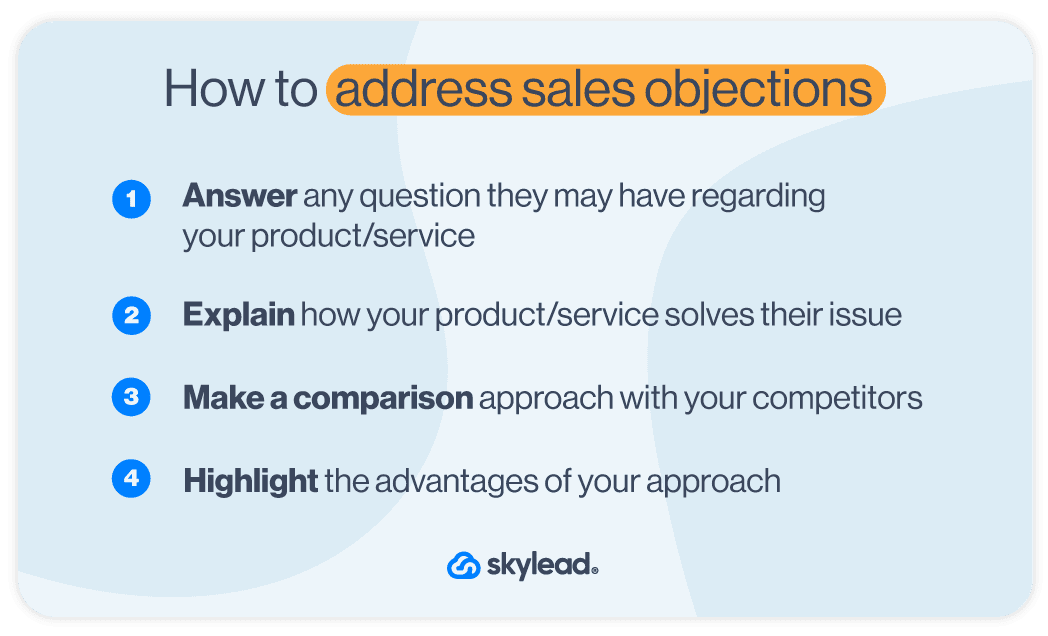
No-problem sales objection
Next, we have the so-called “no-problem” sales objection type. In this situation, the prospect doesn’t perceive the problem as a big deal–in fact, it doesn’t concern him as much. This is a situation where you have to create a sense of urgency and subtly present your product/service as the only solution.
How did this happen? Well, our Account executive, Pavle, says that this objective type might pop up when you show the prospect all features and benefits immediately or without actively listening to what they see as a more important issue.
Problem-oriented sales objection
The hardest one to overcome is the problem-oriented sales objection—the case where the prospect has legitimate issues and doesn’t see how your product/service solves them.
If this is the case, we advise you to first determine if your product can actually help. If it doesn’t, it’s better to be honest with the prospect. This way, you’re actually building a positive relationship that might turn into a good recommendation or a potential future collaboration. However, if it does help, make sure to offer your product and depict it as the logical solution to their pain point.
7 steps to overcome sales objections
Now, let’s look at the tested and trialed steps our sales team always uses when addressing doubts and objections with prospects. 👇
1. Actively listen to prospects
Our Andrea says that to be a successful salesperson, you must learn how to listen rather than reply. Active listening can be described as the most important skill a salesperson should have.
Most of the sales processes nowadays happen remotely and online, so salespeople don’t have the luxury of reading into body language or even tone of voice. The only thing they have is their digital written replies, which is why listening carefully can improve your relationship with the prospect and ultimately lead to a conversion.
2. Repeat what you hear
Since there’s usually no physical interaction between you and your prospect, it’s important that you phrase your questions and answers in a way that replaces a specific reassuring tone of voice and microexpressions on your face. So, when a prospect voices an objection, make sure to repeat it back to them for two reasons:
- To make sure you understand their issue correctly which can help you change their mind later.
- To make them feel valued and heard by you, which builds trust further.
3. Validate concerns
This step comes after you’re sure you understand your prospect’s worries. From this point, you can continue building trust with them by empathizing and showing them you understand their viewpoint. By validating their concerns, you can lead them to the part where you unobtrusively introduce your product/service as a proper solution.
This is how validating concerns looks like in real life:
I understand that implementing a new tool can lead to a rocky adaptation period. Luckily, our all-star support team is here to help ease the transition and get you to operate as before but better.
4. Ask open-ended follow-up questions
When an objection comes in front of your potential sale, your main job is to keep the conversation going. To keep them engaged, be sure to ask follow-up questions. However, you should avoid questions that can be answered with “no” or “yes”.
Instead, focus on open-ended questions that allow your lead to keep communicating their thoughts and worries so you can address them as soon as possible. The more information they give you, the more material you will have to turn the objection around into a sale.
Can you walk me through some of the challenges you're currently facing in managing your {{process/Task}} and how you see the perfect solution to improving your situation?
5. Use social proof
When in doubt, use social proof to change your prospect’s mind. The best way to persuade them is to showcase a customer story, case study, or data addressing their pain points.
Here’s an example of a case where your social proof addresses their objection or pain point:

6. Give them time to think before your next follow-up
In objection handling, there will be situations where your prospect will ask you to give them some time and space to think about their options or to restart the conversation in the future. Your job here is to give them enough time and space but not too much. If you leave them for too long, they might lose track of you and your product/service, and this is why a follow-up that restarts the conversation is an absolute must!
So, be sure to set a time that isn’t too far in the future, and make sure to let your prospect know that you will answer any questions and discuss any news regarding your product/service.
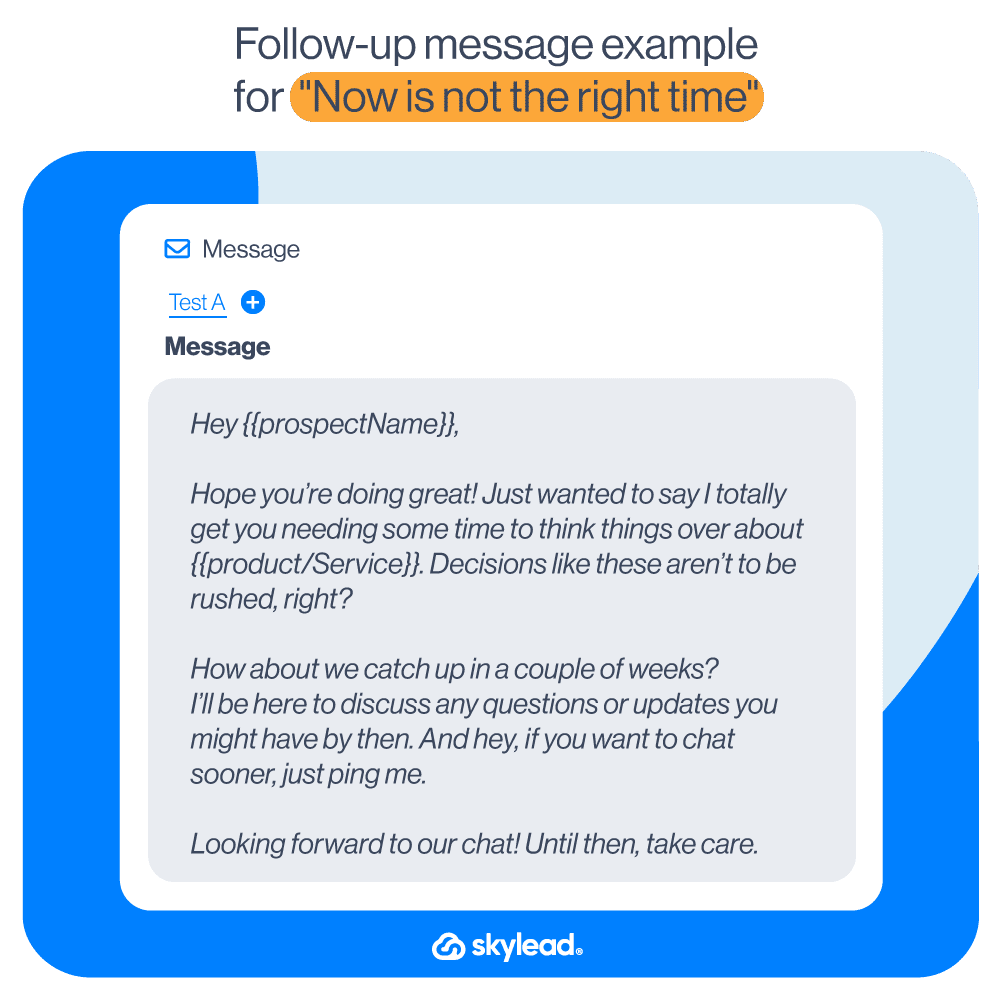
7. Address objections before the prospect does
Ultimately, a good salesperson is the one who can predict and cover potential objections and worries before the prospect mentions them. If you’re working in a certain field and with prospects from a certain industry, you most likely are already familiar with the type of worries that might come up, so it’s good to sew in subtle objection-handling cues into your sales pitch.
Top 17 objection-handling situations with rebuttal examples
Now that we’ve covered why it’s important, the types of objections out there, and our 7-step guide on how to handle and overcome objections, it’s time to look at the 17 most common objections. Our superstar sales team came together to tell us all about the reasons they had to work around over the years. Let’s begin handling objections. ⬇️
#1 I already have a solution
This one is the most common objection, and it usually involves your direct or indirect competitor. The way to work around this is to find your prospect’s pain point that their current solutions don't solve. Depending on how the prospect ends the sentence, your response may vary, so let’s see all the potential scenarios.
Rebuttal examples
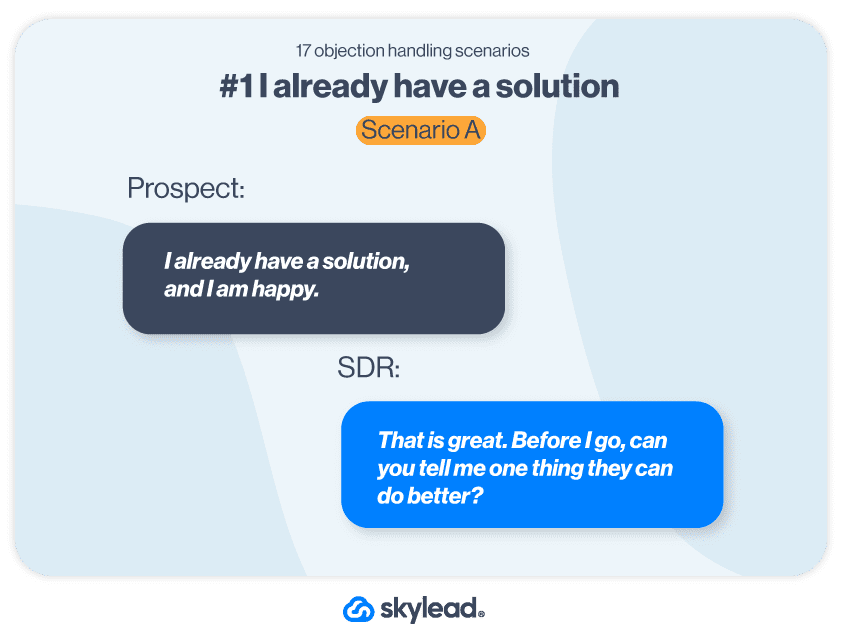
Tease out why they think the solution is good for them, and gather the pain points based on which you can book a meeting. If their feature is really better, leverage the one your product has and think it’s better for the prospect’s business.
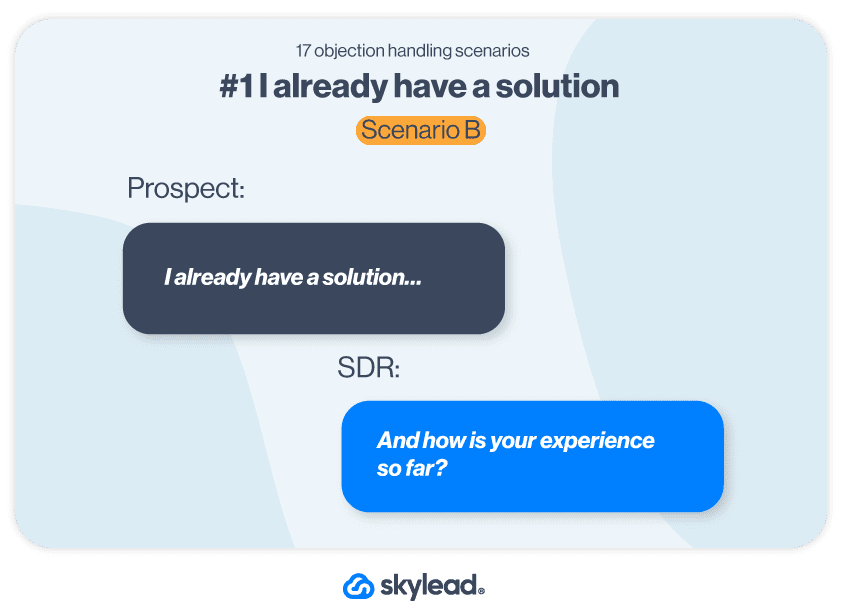
Tease pain points to continue the conversion. Pausing may imply that they are not satisfied with something. Then it’s your job to figure out which part the competitor isn’t covering so you can sweep in and solve the problem.
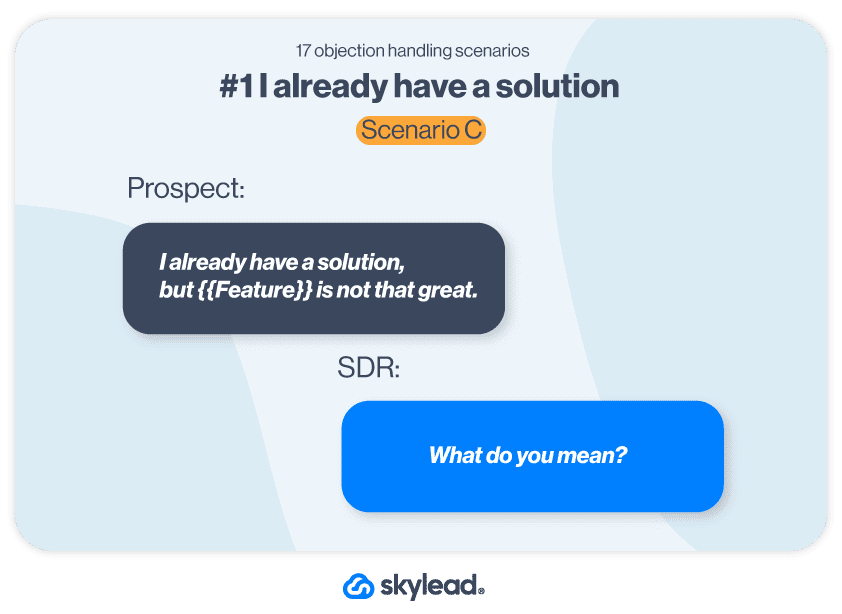
Needless to say this is the best answer you can get, as the prospect immediately pointed out the pain point. Ask more questions, empathize with them, and then underline the value of your product/service to move the conversion process forward.
#2 I am not the right person
From Becc Holland’s experience, the CEO and founder at Flip the Script, sometimes, in cold outreach, you will talk to people who are not the decision-makers. From our experience, if you build a good initial relationship with them, they could point you to, or even connect you with the decision-maker, so don’t dismiss them right away!
Rebuttal examples
Make sure to listen or read carefully if they are indeed the right person or not.
If they are but say they aren’t just to chase you away, structure your objection handling response like this:
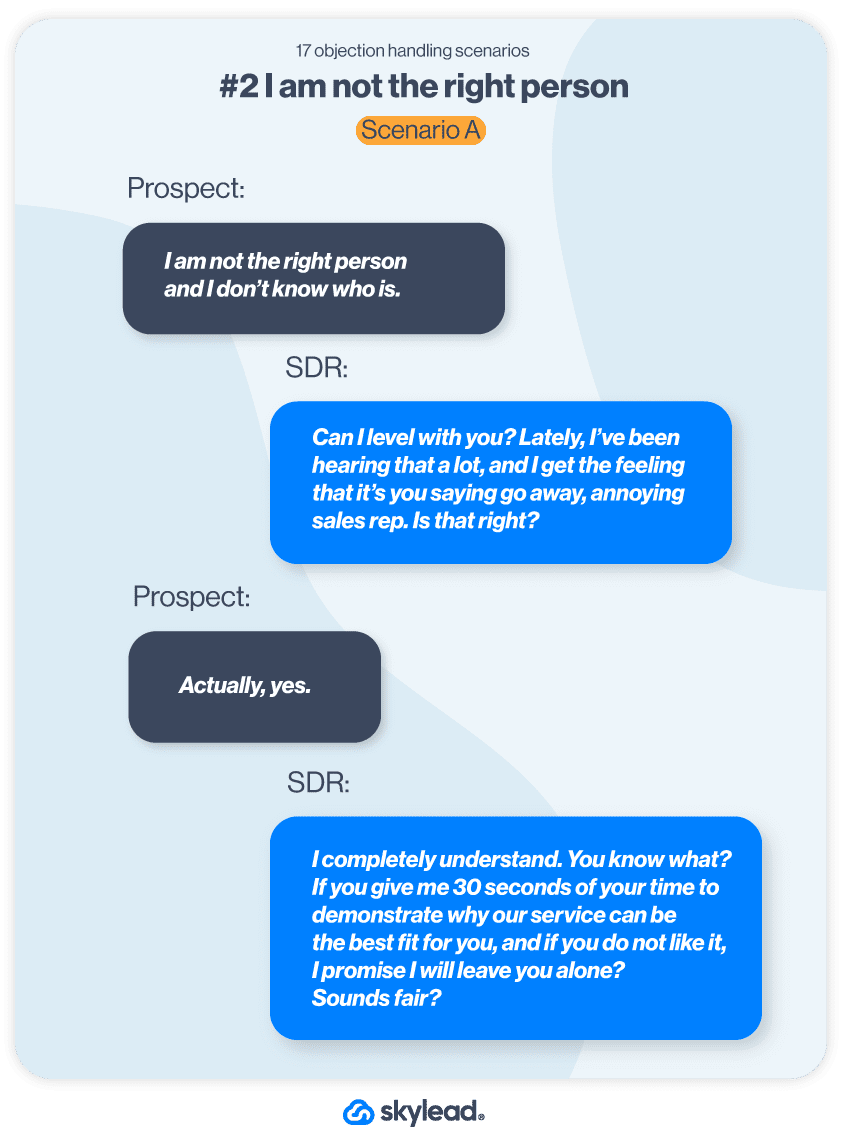
After you ask for consent to pitch and they give it to you, pitch a unique selling point and value proposition to try to close the deal or schedule a demo call.
In case they're not the right person, structure your response like this:
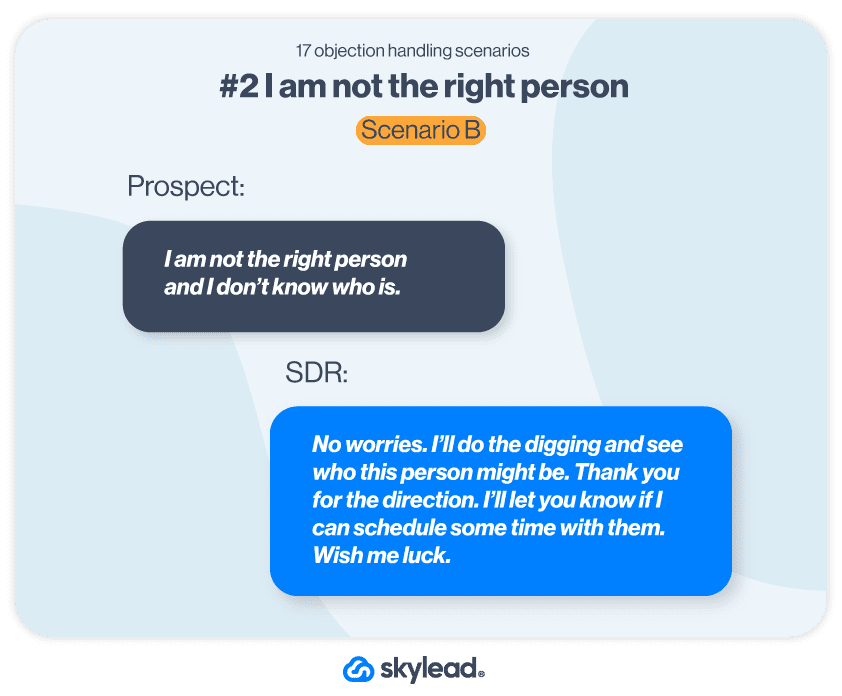
If you find the decision maker, you can always reference the person you spoke with first. If you don't succeed, you can reach back to the first person and ask for additional advice or to point you to the right person.
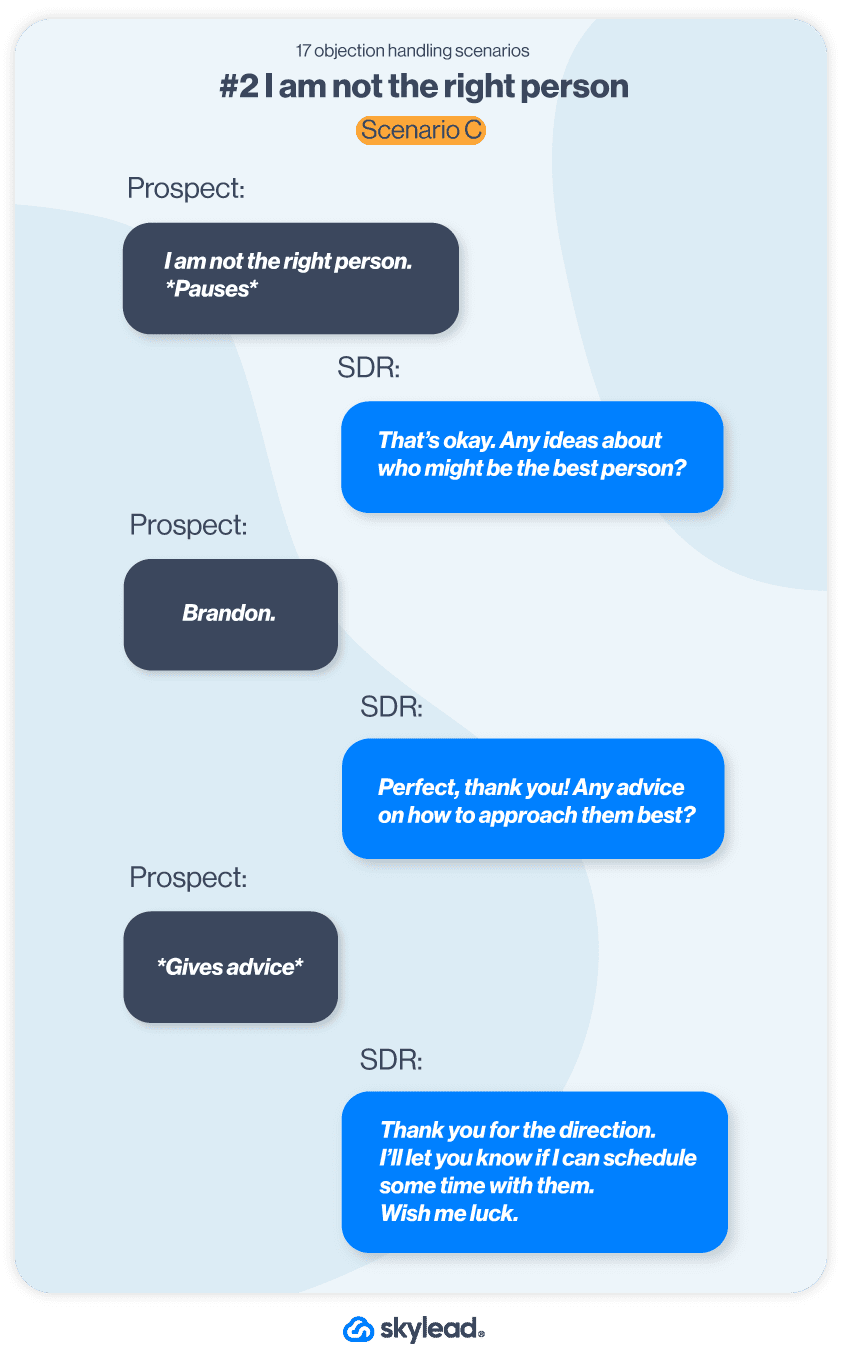
However, if you can’t reach the decision-maker, reach back to the first person and give them an update. Be honest, admit you might have made a mistake, and ask for advice again. The first person will probably want to make things right and reach the decision-maker themselves.
#3 I don’t have time
As an SDR, your job is to prove to your prospects that you are worth their time. For example, by using short sentences you’re showing you respect their time. You will also catch their attention by showcasing the experience of similar people, and then ask for a fragment of their time to pitch or aim to schedule a call for another time.
Rebuttal examples
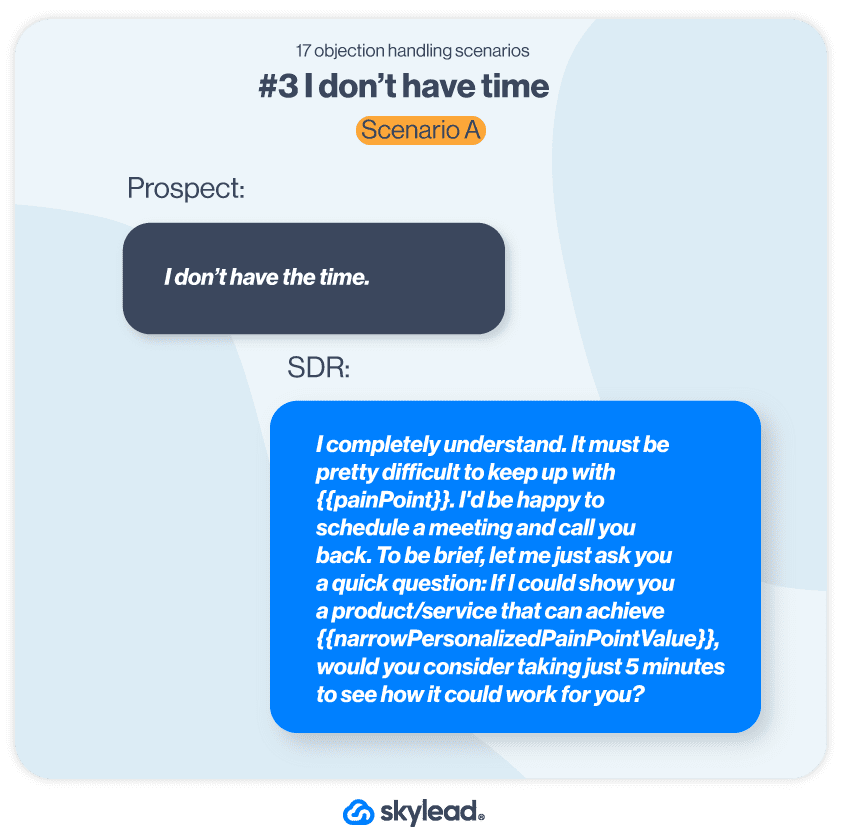
With this question, you are providing the value and solution right away and showing you are respecting their time. They may or may not have the time right now, but you teased enough to schedule a call another time and soon. Ask them again if they have that 5 minutes right now, or if they do not, when you should schedule a short call.
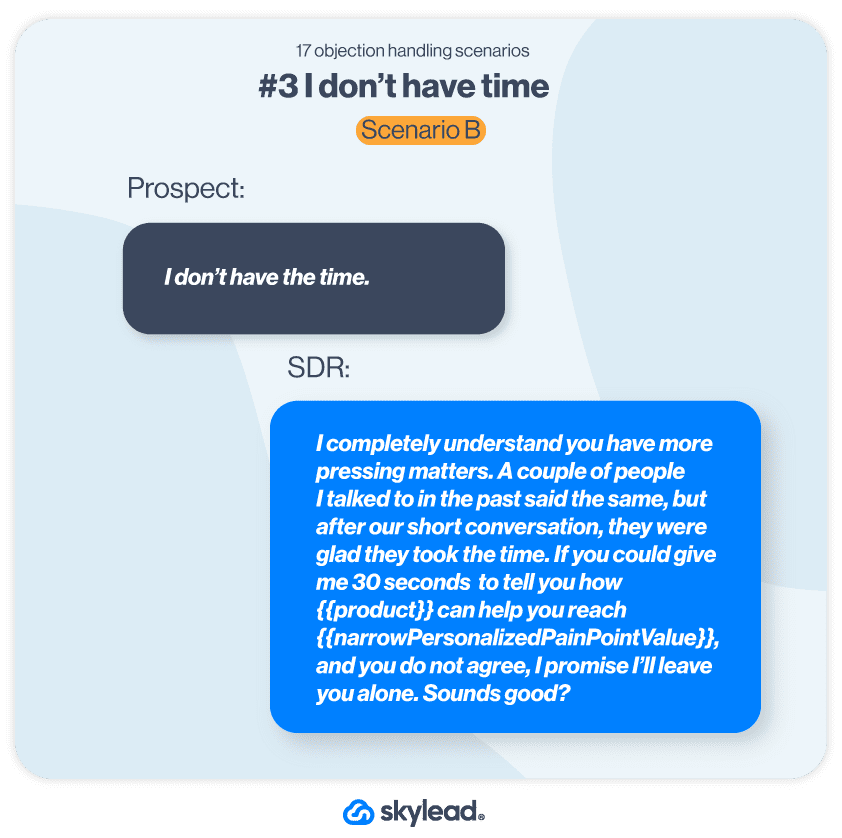
With this statement, you get the chance to pitch right away, so try to be as brief as possible, and finish by asking for another call.
#4 The budget is a little tight at the moment
Price objections are the type of sales objections you want to hear, as it shows the prospect thought of buying your product/service, but had to reconsider because of the price. These prospects usually need a little nudge value-wise and they’ll convert.
Rebuttal example
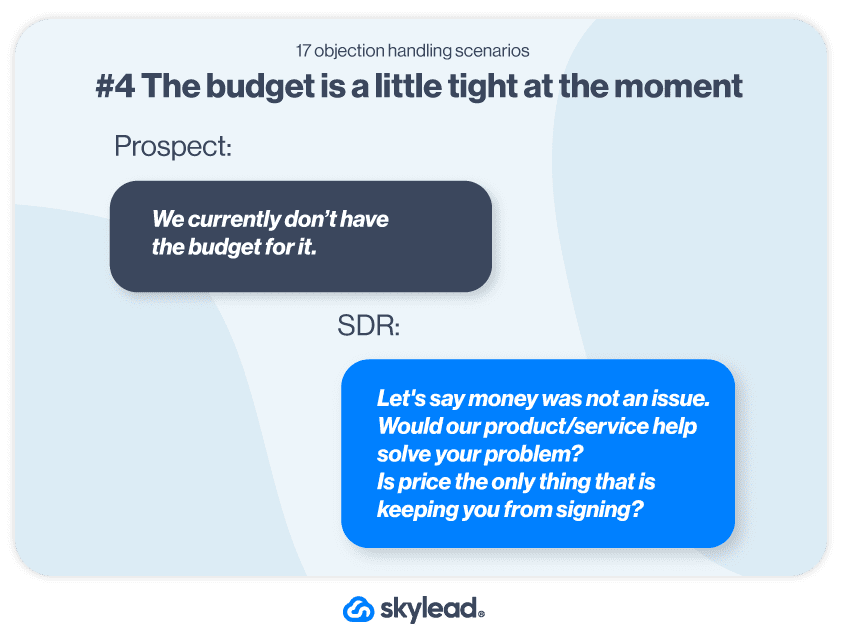
If the answer is yes, you have the opportunity to offer a discount code to push them towards the closing process. If not, ask more questions to find out the real reason, then leverage it to remove it with personalized value.
#5 You are more expensive than your competitors
Similar to the previous one, this objection has the money issue involved, but with an added spicy competitor comment. Try to stay calm as this is solvable 90% of the time. You overturn this by showing how they can win with your product as opposed to losing with the cheaper alternative.
Rebuttal example
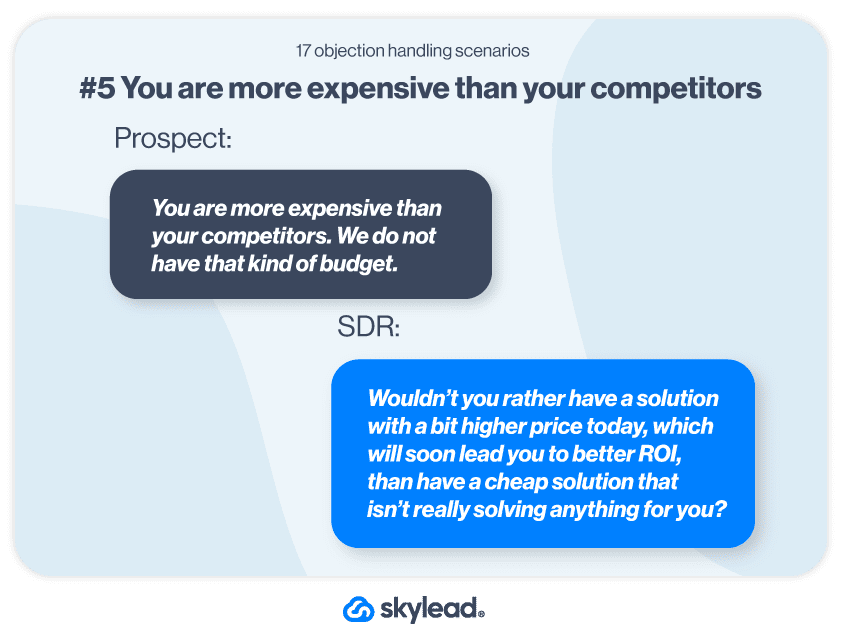
The moment you start justifying the price, you’re bargaining with the prospect. Rather than addressing the price issue alone, our Andrea says that you should link the price to the higher value that your product offers. If they still don’t understand, then they probably do not match your Ideal Customer Profile.
#6 I need to check with the boss, or my boss doesn’t like this product, but I do
Sometimes, the person you are pitching to will not have the authority to make final decisions. However, you should not lose interest in pitching to this person, as they might be the ones who will use the product in the end. If you make a good impression, they might pitch it to their boss, and the conversation and the conversion will continue.

Rebuttal examples
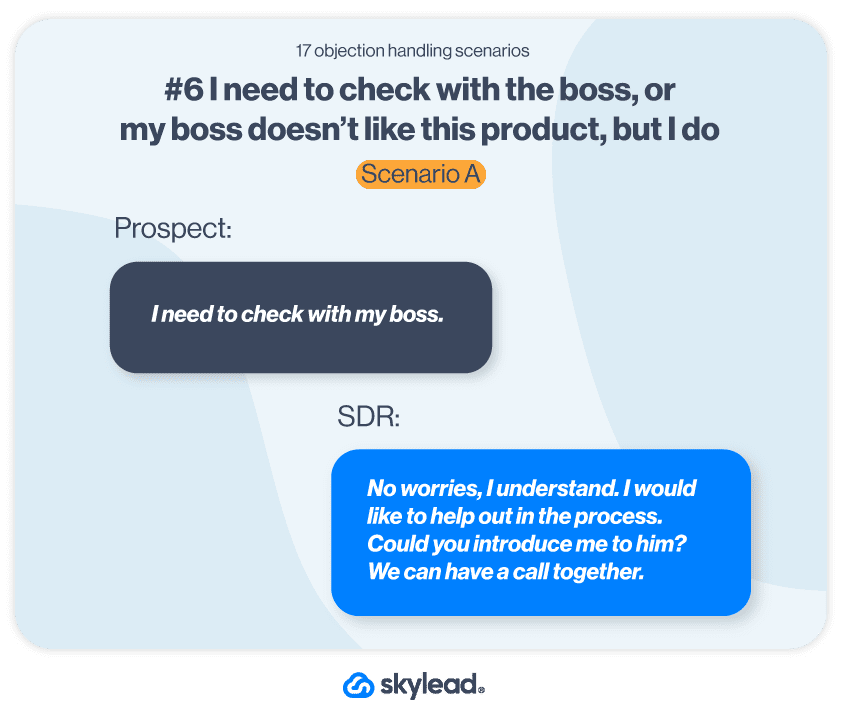
Andrea says that you shouldn’t never allow anyone else to deliver your sales pitch to the decision-maker. Instead, aim to schedule a call with them to provide value. Be careful not to make the person not in charge feel inferior, though. So, instead offer them help and support in the pitching process. If they don’t want to schedule the call, offer to send the necessary info.
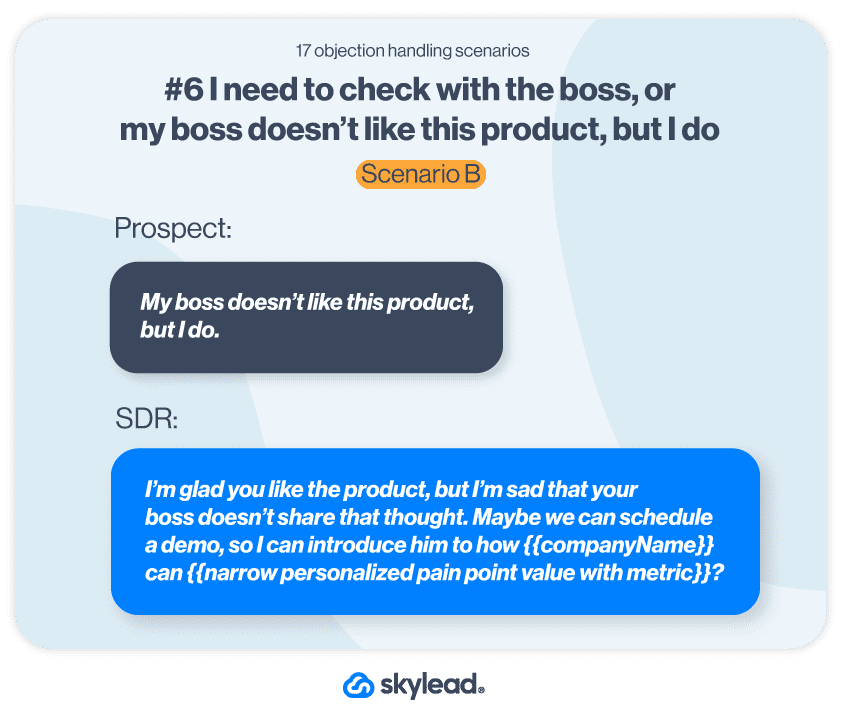
Give them the exact metric of the value your product offers so that the person can use that as leverage to schedule a call with their boss.
#7 Reach out to me next month/year
Sometimes the prospects will be busy with their heavy workloads. In this situation, you should approach by explaining that you understand. Also, highlight the fact that your product/service can actually help them and improve their work experience.
Rebuttal example
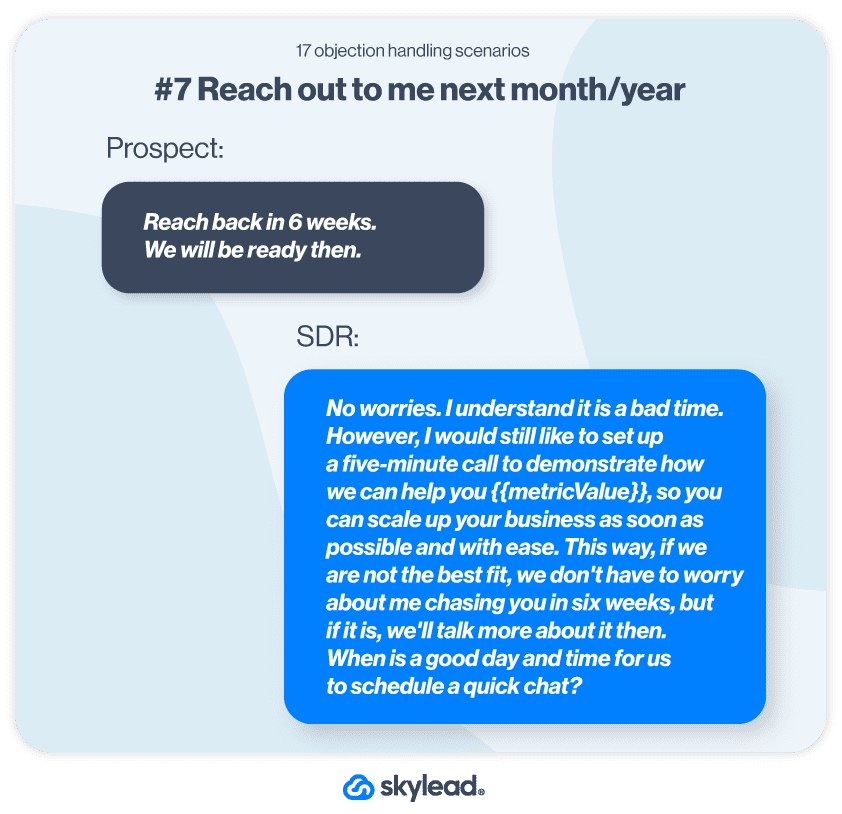
Reassure them that this is not a buying conversation. You just want to show them how valuable your product is and what it can do for them right away.
#8 Send info over the email
This is a common objection when cold calling or after a demo. In most cases, this means that the prospect has already made up their mind. By asking you to send more information, they hope to cut the conversation short. Don’t let that get to you. 👇
Rebuttal example
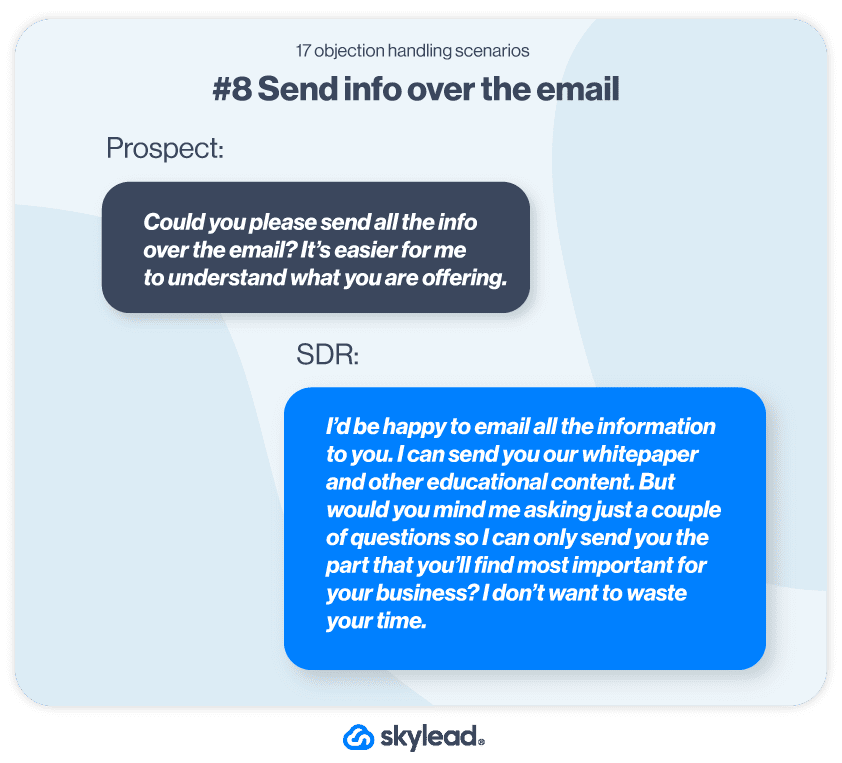
Agree to send the information, but not before asking questions about their business to understand their pain point better.
#9 I’m not interested in your offer
Ouch! This objection is also a pretty common one, but again, you should not let it throw you off your game. You should ask yourself this: How are they not interested if they didn’t even hear your offer? The truth is that this objection usually means that they are busy. Turn it to your advantage by restructuring your introduction to focus on the expertise.
Rebuttal example
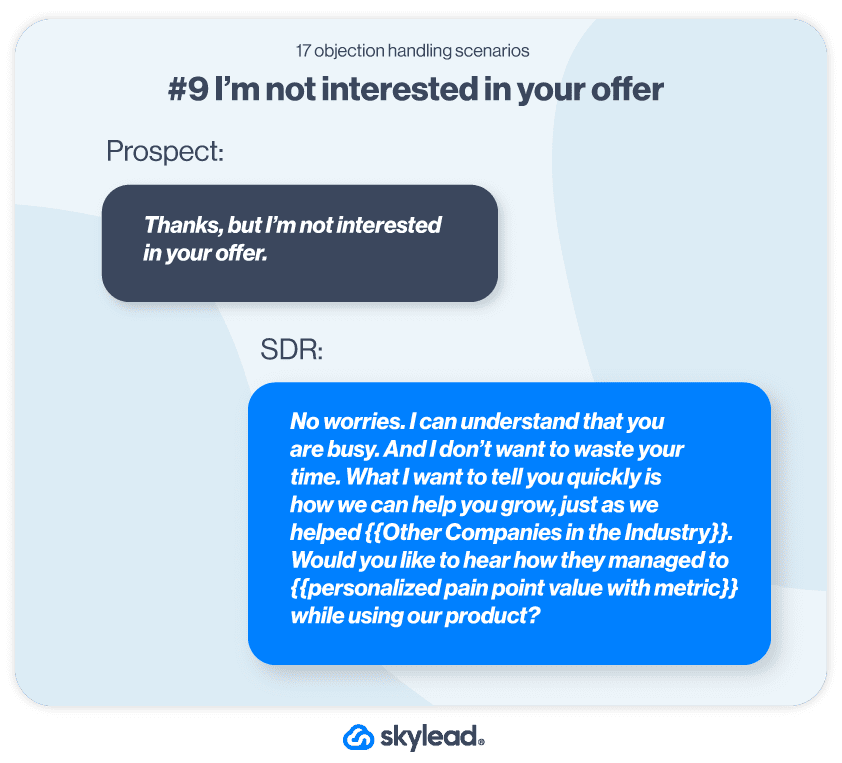
Try to keep the conversation going, just so you can demonstrate expertise using their pain point. This way, your prospect can see that you have relevant experience to back up your claims and that you know your worth. A true objection handling win! 💪
#10 Pitching back
This is an objection that became pretty common nowadays. It’s when B2B companies pitch you back, usually on demo calls. Translation? They are not interested in your product/service - they are just using the chance to show you their own. The audacity, right?
There is nothing wrong with presenting your solution, but if they only agree to the call to pitch you back, that’s just sneaky.
Rebuttal example
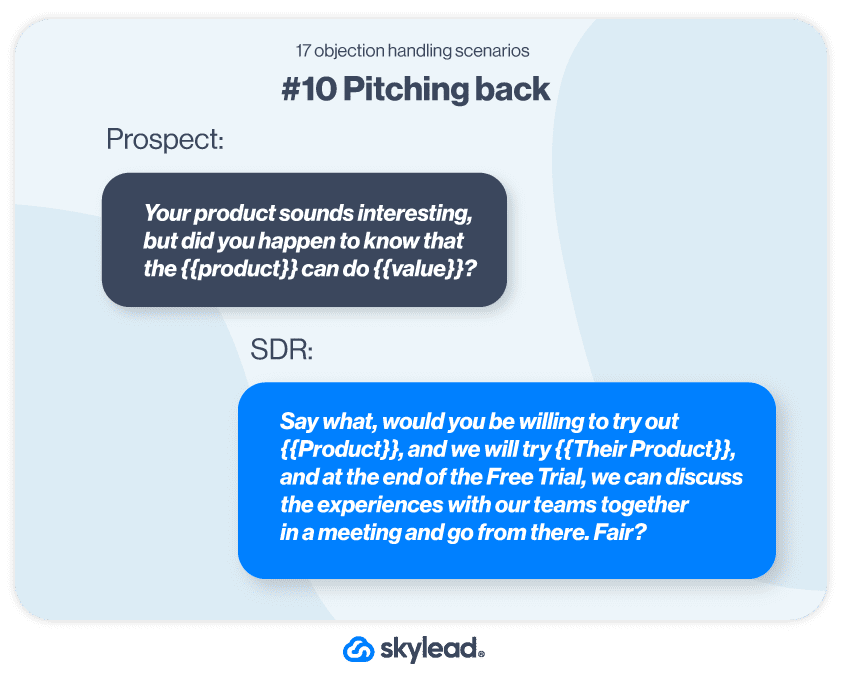
Proposing a collaboration will definitely catch them off guard, and there is a chance that their decision-maker will see the value you offer.
#11 Your product doesn't have {{feature}}, and we need it.
This objection could be a tricky one, but try to suggest an alternative solution used alongside yours. In case this need is a must for them and your product can’t solve it, then your prospect might not be the one for you. Before you write them off, try this 👇
Rebuttal example
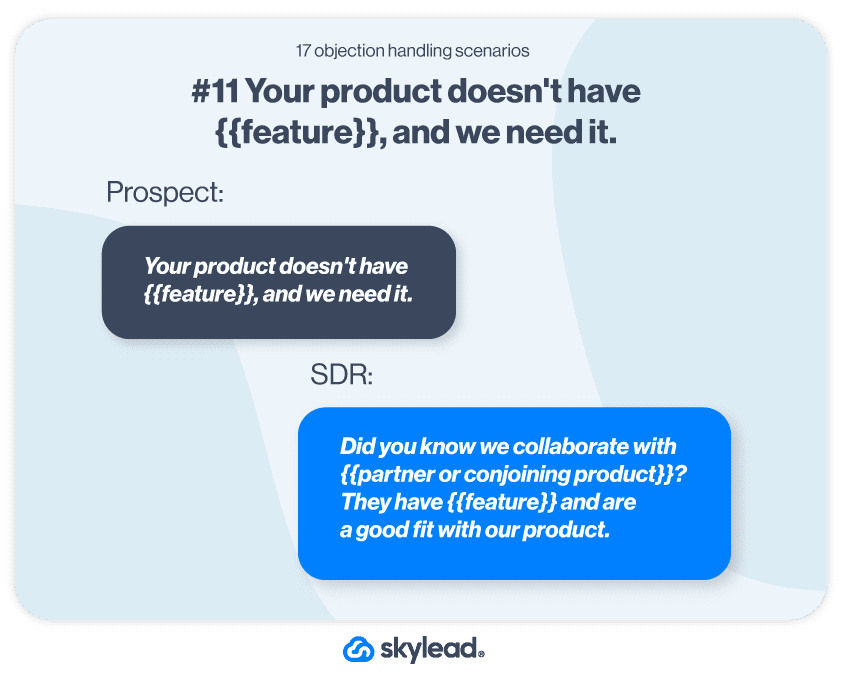
#12 We're happy with the way things are now.
Sometimes, this could be the case. But that doesn’t mean you should believe them right away. Ask more questions to get into potential problems they might be facing. If the answer is still no, move on. ⏭️
Rebuttal example
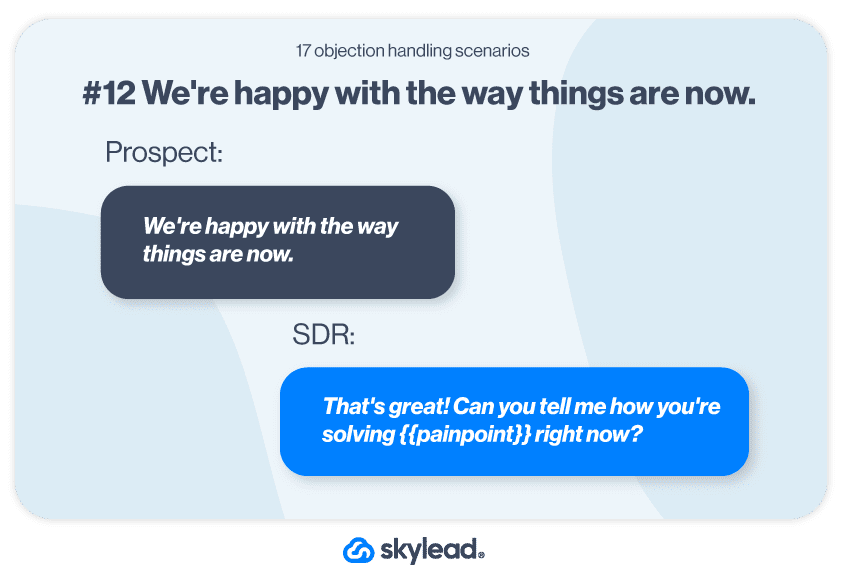
#13 Your product is too complicated.
In this case, make sure to ask questions and find out if a specific feature or the entire product is too complicated for them. In both cases, you should clarify any concern they might have and add that your customer support team will help them set everything up smoothly if they choose to buy.
Rebuttal example
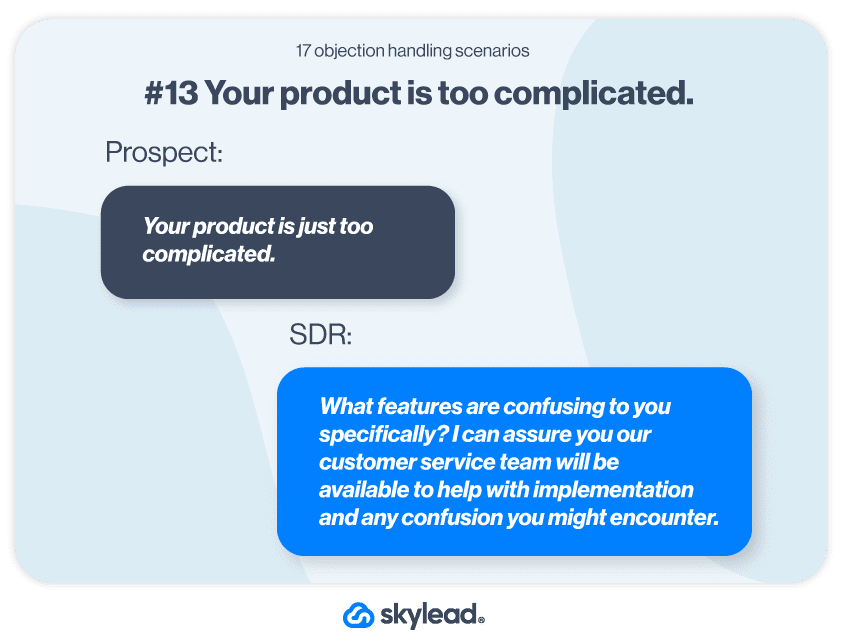
#14 I don't see what your product could do for me.
This objection usually means there’s some information that needs to be presented. So, your job here is to confirm their goals and pain points, and then explain how your product/service fixes these issues for them.
Rebuttal example
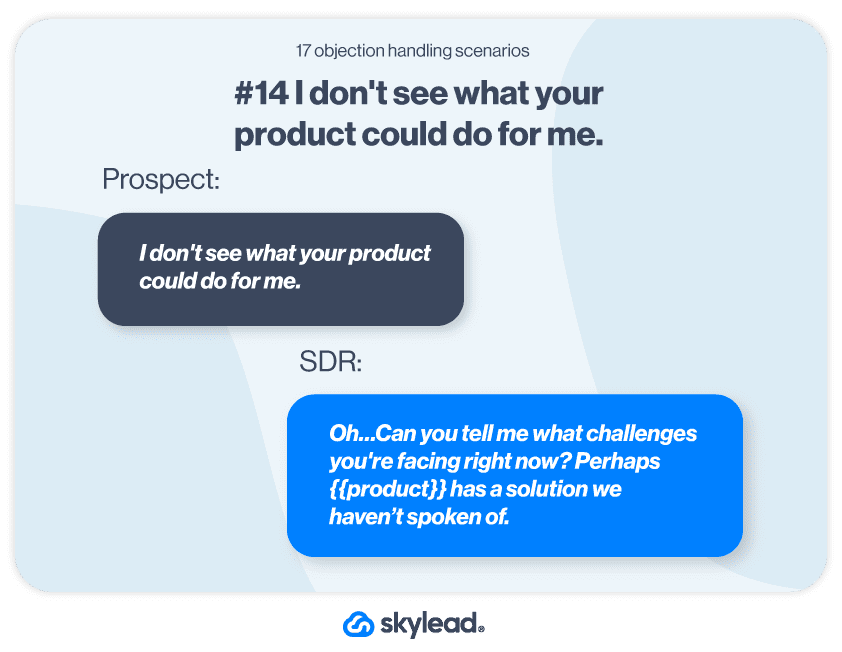
#15 {{Painpoint}} isn't important right now.
In this case, there might be two reasons the prospect is stating the objective. First, they might want to let you down easy, or you need to ask more questions to find out why this isn’t important right now, so you can explain why it’s a great time to rethink their priorities. Try to create a sense of urgency and work from there.
Rebuttal example
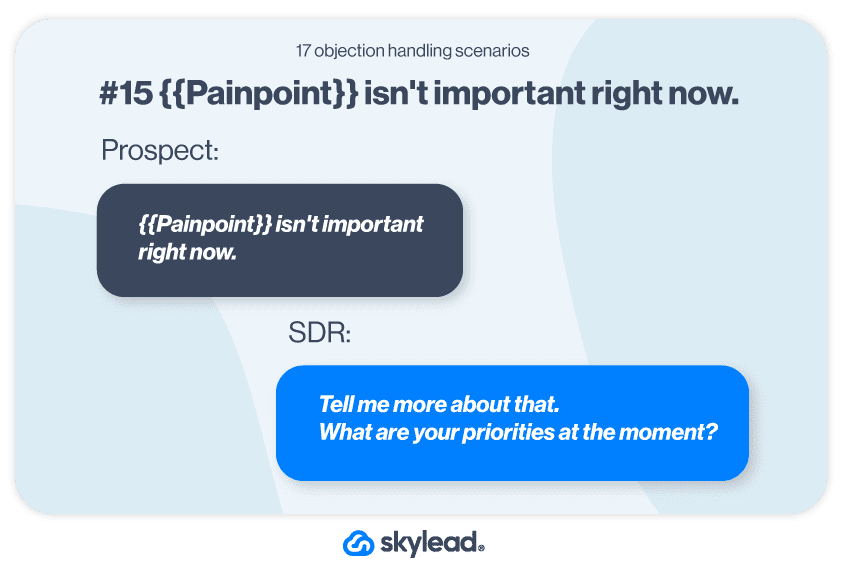
#16 I'm happy with {{competitor}}.
What do you do if the prospects say they’re happy? You don’t buy it! First you find out why they are content with the way your competition works for them. Second, try to identify potential weak points and subtly underline how your product solves them.
Rebuttal example
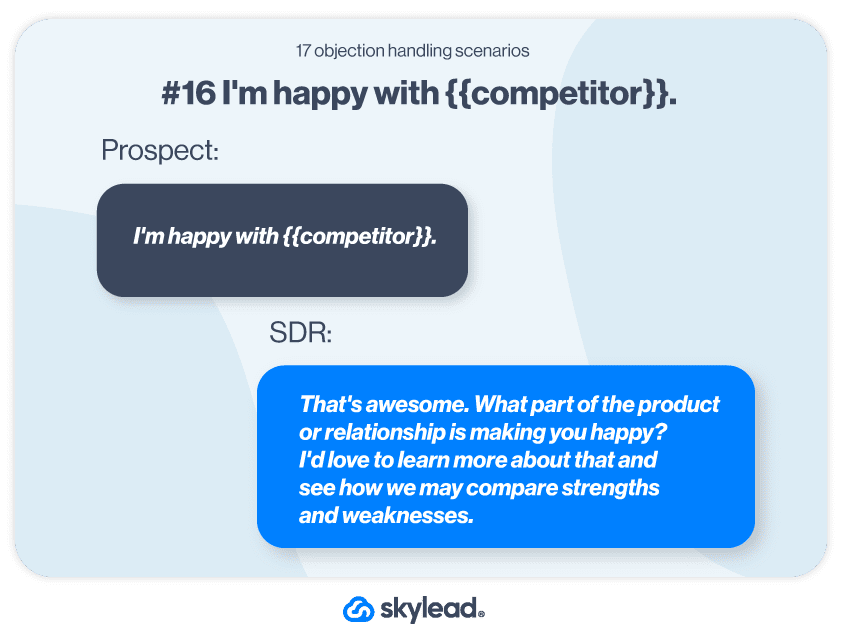
#17 We need to use that budget somewhere else.
If this objection shows up, your main goal should be to make them believe that the budget should be redirected, or rather, invested toward your product/service. This is where social proof comes in as your best friend, so don’t be afraid to throw around some numbers.
Rebuttal example
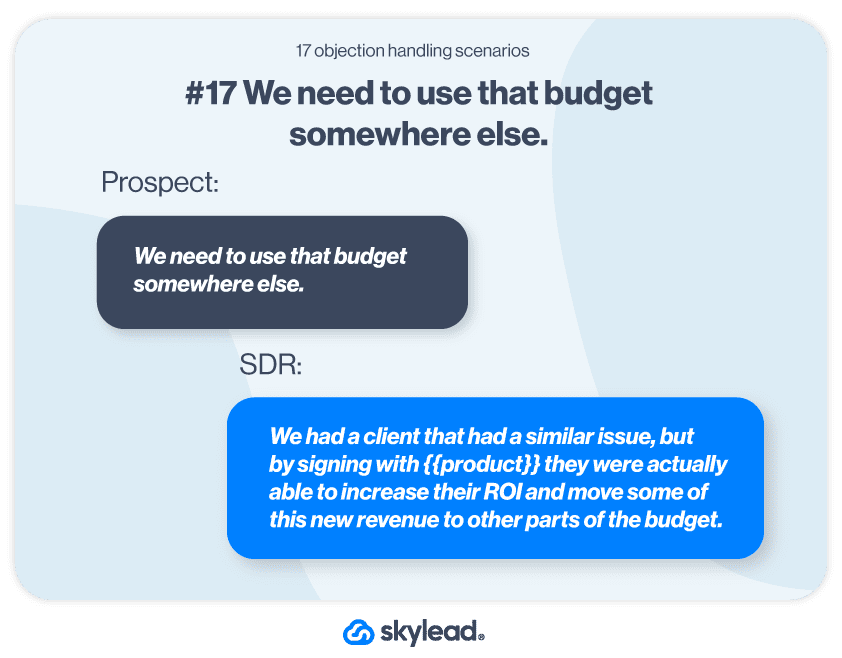
Frequently asked questions - FAQ
How do you tailor objection handling strategies for different industries or sectors?
Tailoring objection handling strategies to different industries or sectors requires an understanding of the unique challenges and needs of each market. For instance, objection handling in the tech industry often involves addressing concerns about integration and compatibility with existing systems, whereas in healthcare, the focus might be on compliance and patient privacy. Sales reps should research industry-specific pain points and prepare tailored responses that resonate with their audience.
Can objection handling techniques be applied to digital sales channels, like social media or email marketing, and if so, how?
When it comes to digital sales channels like social media or email marketing, objection handling techniques need to be adapted for the medium. Since direct interaction is limited, sales reps can use targeted content to preemptively address common objections. For example, FAQs, customer testimonials, and detailed product information can help overcome objections before they are even raised. Engaging with comments or inquiries promptly and thoughtfully on social media can also mirror the empathetic listening aspect of objection handling in a more public forum.
How do you measure the effectiveness of your objection handling efforts?
Measuring the effectiveness of objection handling efforts involves tracking sales metrics such as conversion rates, the number of objections encountered versus those successfully addressed, and customer feedback. Sales teams can conduct regular reviews of sales calls and meetings to identify patterns in objections and assess how well they are being handled. Customer feedback, through surveys or follow-up conversations, can provide valuable insights into whether objections were adequately addressed. Over time, this data can inform training and strategy adjustments to improve objection handling and, consequently, sales outcomes.
Ready to handle these objections with ease?
We know the answer: Yes, you are! With the knowledge we’ve gathered, you can up your sales game and handle objections like a pro. If you face an objection that gives you sales nightmares, you can always come back to this blog for inspiration on how to handle it.
Remember to collect all information and to approach each objection handling situation like you’re there to help them. That’s the only way you can build a solid relationship with your prospects. 🤝
So, before we let you go outreach away, we think you should also give Skylead a try and automate the outreach process while you’re at it. You’ll save lots of time, which you can use to build and nurture strong relationships with prospects.
The best thing about it is you can sign up for a 7-day free trial and check how the tool works with your own eyes. You won’t regret it, plus those objections will be easier to handle now that the tool is handling half of your workload. 👀
